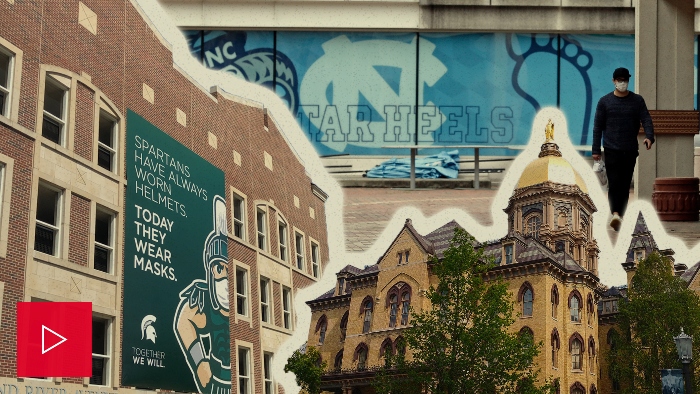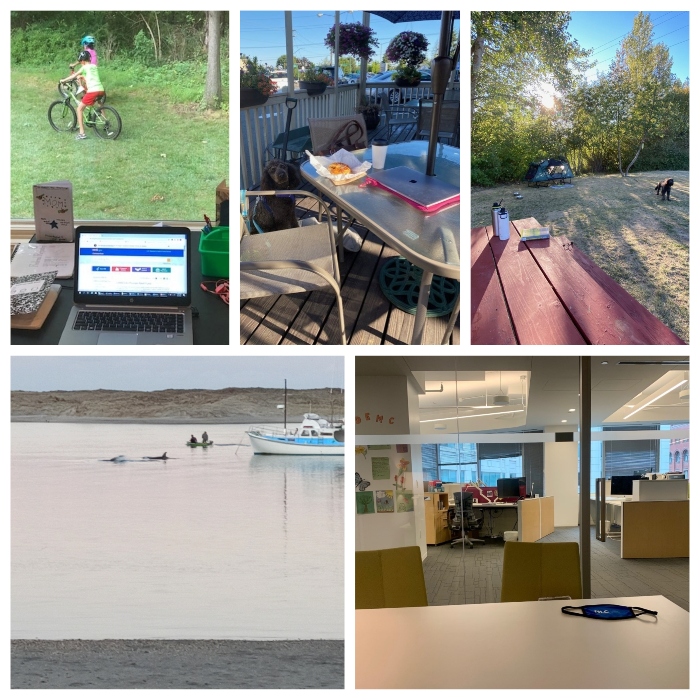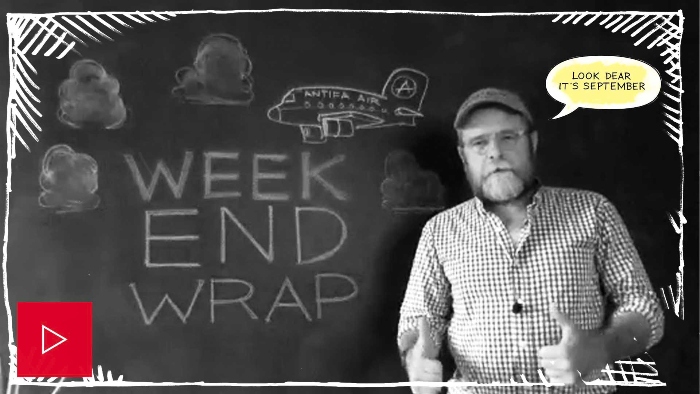| | |  | BY MYAH WARD AND RENUKA RAYASAM | | 
| BACK TO SCHOOL NIGHTMARE — I can’t say that I was entirely surprised when my alma mater, the University of North Carolina at Chapel Hill, became the face of the disastrous reopening of American colleges. While school administrators touted their roadmap for bringing students back to class, others saw the warning signs. “I think this road leads to a disaster,” said one UNC history professor. University workers have said that they weren’t given proper protective equipment. And there was no testing protocol for students, Anna Pogarcic, the editor-in-chief at The Daily Tar Heel, told me in a Zoom call with college journalists this week. The local health department warned school administrators to delay — they didn’t. A week after parents dropped off their kids in Chapel Hill, they had to drive back and pick them up, as Covid clusters proliferated across campus. “Once that first cluster was reported, after we hadn’t even been on campus for a full week, we all started kind of freaking out and wondering, like, 'how far is this gonna go?’” Pogarcic said. More than 6 percent of the nearly 3,000 colleges and universities Davidson College is tracking chose to start the semester entirely online. At historically black schools that are members of the United Negro College Fund, that figure rises to 38 percent. But other schools, like UNC, tried their hand at teaching primarily in person. At least 180 colleges and universities have had to adjust their plans, with 78 moving to remote classes. In-person college reopening plans had one fatal flaw: They relied too heavily on students to police their own behavior. Instead of concrete plans to deal with the inevitable virus spread, school officials shifted responsibility to students, ordering them not to gather. Universities were surprisingly unprepared to deal with young adults’ irresistible need to socialize, especially after an extended hiatus where they were largely locked at home with their parents. And that is exactly what happened: from fraternity and sorority rush parties to innocent games of Monopoly. “I think one of the things that’s really challenging in this pandemic is how difficult it is to predict what will happen because it is so dependent on our behavior,” said Gypsyamber D’Souza, a professor of epidemiology at Johns Hopkins University. “We have classroom risks, we have dining hall risks, there’s the risks in the dorms, transportation, then there’s the social settings.” It’s been a jarring fall semester for college students across the country. A friend of mine who is set to graduate from UNC next May lives in an off-campus house with a group of other students (they signed their lease last fall, long before anyone had any inkling of Covid-19). Just last week, she was quarantined in her room waiting for one of her housemates to receive Covid test results. “It’ll be a...fun birthday,” she texted me. My college roommate’s younger sister just started her freshman year at Ohio State. It’s typical for roommates to meet early in the semester to discuss pet peeves and boundaries, but she said their initial meeting was far more fraught: The new roommates agreed not to party, and only to spend time with their suitemates. Notre Dame moved to remote classes for two weeks after a spike in cases on Aug. 18. Senior Claire Rafford has been trapped in her single dorm room on the school’s South Bend campus, which her friends living off campus are banned from visiting. Now Notre Dame is giving in-person classes another go. Like students across the country, Rafford, assistant managing editor at The Observer, has no idea whether the second attempt will work better than the first. Pogarcic, of UNC, is already worried about the spring semester. “North Carolina’s Covid-19 numbers overall haven’t improved,” she said. “Based on factors now, I’m not sure if they’re going to by the time we need to come back in January. I’m wondering if UNC is going to try to reopen again, and if they’re going to send us back home within a week again.” Welcome to POLITICO Nightly: Coronavirus Special Edition. Happy birthday to my baby boy and Beyoncé. Reach out rrayasam@politico.com or on Twitter at @renurayasam.
| |
| | BEIJING IS WATCHING, ARE YOU? China has long been a nation of involved and cynical election-watchers, at least when it comes to American presidential campaigns. As the United States races toward election day, how do Chinese citizens believe each candidate would impact relations between the two nations? Join the conversation and gain expert insight from informed and influential voices in government, business, law, and tech. China Watcher is as much of a platform as it is a newsletter. Subscribe today. | | | | | | | LAW AND ORDER HITS THE STREETS — A take-to-the-streets MAGA movement that started online has become a reality, egged on by the oblique encouragement of President Donald Trump and only limited pushback from conservative leaders. It’s a call to arms that has been bubbling online for weeks, circulating among white nationalist-affiliated groups and in local Facebook groups as they watched nationwide racial justice protests and sporadic outbreaks of violence and destruction. Armed vigilantes began showing up at the demonstrations, saying they were there to defend property and arguing Democrats had let lawlessness roam the streets, White House reporter Tina Nguyen writes. The recent violent clashes in Portland and Kenosha, Wis., represent a turning point in the effort. In Portland, Trump supporters showed up as counter-protesters, and one of them ended up shot and killed. And in Kenosha, 17-year-old Trump backer Kyle Rittenhouse was charged with killing two people in a city that bridges the divide between major urban centers and suburban America. It’s a development Trump and his team have latched onto as they try to win back much-needed suburban voters with a law-and-order message. Trump has branded the racial justice protesters “domestic terror,” praised the Trump-supporting counter-protesters, defended Rittenhouse’s actions and traveled to Kenosha on Tuesday to misleadingly take credit for stopping violence in the city and other urban areas. “It’s all Democrat, everything is Democrat, all of these problems are Democratic cities,” he told reporters during his visit. The rhetoric is part of Trump’s two-track messaging as he heads into the final two months of the campaign. To his supporters, it’s an implication: I’ll look the other way if you show up. And to suburban voters, it’s a proclamation: The states have abdicated their duties, and only I can fix the violence that’s creeping closer.
| | ‘NO ADULT SUPERVISION’ — A White House adviser in charge of vaccine development said Thursday that it was “extremely unlikely” a Covid vaccine would be available by Election Day, contradicting CDC guidance telling states to prepare for vaccine distribution by Nov. 1. This evening, Trump contradicted that official, saying a vaccine would probably be ready by October. The mixed messages are just another sign of the dysfunctional public health messaging coming from the Trump Administration, which risk undermining the country’s confidence in a vaccine, Peter Hotez, dean for the National School of Tropical Medicine at the Baylor College of Medicine, told Nightly today. Your host spoke with Hotez about why a Covid-19 vaccine won’t be available this fall, how he thinks the administration is screwing up communications about vaccine development and why we should trust a future vaccine, anyway. This conversation has been edited. Do you think we will have a vaccine by Nov. 1? Not really. Because if you look at phase 1 trial data from the first ones to go into clinical testing in the U.S., they all require at least two doses to give a meaningful immune response. If you are giving two doses a month apart, it is going to take time to dose 30,000 human volunteers. Then you have to give it time to show that there’s a difference between vaccinated individuals and controls. It seems like we’re getting mixed messages from the Trump administration about vaccine development — why is that a problem? We're going to require an unprecedented level of public health communications at a time when the U.S. government has never failed more miserably at science communication. There seems to be no adult supervision over the whole program. Keep in mind that there’s gonna be different vaccines and some will be more effective. Some will reduce severity of illness. Others will prevent infection. What we need to do is provide realistic expectations of what a vaccine does. We’re still going to need masks and contact tracing, and we’re still going to need a pretty high level of public health intervention. I have an MD and a PhD. Ivm an expert vaccine scientist and it’s very confusing for me to try to figure out [what the White House is saying]. I can imagine the frustration for the average person. Aside from the communication part, how would you say Operation Warp Speed is going? The quality of the science is good. The clinical trials are well done. So, you know, people like myself try to put the best foot forward on what the government’s doing. They make it a lot tougher. When will we have a vaccine? I think by end of the year you may have data showing that one or more of these vaccines is effective and safe. Q2 of 2021: That’s when we will start seeing significant numbers of vaccines on the market. And should we trust it? If we go through the full review process, I’m quite confident that any vaccine released to the public will be both safe and effective. And I would not hesitate to take one of those vaccines. If you try to shortcut it, whether it’s emergency use authorization or other mechanisms, then you increase the risk that the vaccine might not either work effectively or it might have some safety problems.
| | Nightly asked you: Send us pictures of your Covid-19 work or study space. Below are some of your submissions.
| 
| | | GLOBAL WARNING — Trump’s push to reopen the United States quickly this spring may have saved some short-term economic damage. But indicators both at home and from around the globe suggest that until the U.S. gets its coronavirus outbreak under control, its medium- and long-term economic prospects remain dicey. As governments release their final figures for the second quarter of the year, it’s become clear that, more than anything else, a country’s success or failure combating the pandemic will drive economic performance, Ryan Heath writes. Lockdown measures have taken a toll, which helps explain why parts of Europe and Asia performed far worse, economically, than the U.S. earlier this year. But the approach to reopening, including governments’ willingness to embrace measures like mask mandates, are more predictive of a country’s economic trajectory — whether that be a v-shape, swoosh, bird wing, or one of the many other monikers economists have come up with to describe the course of a recovery after a plunge in output. The variation in countries’ second quarter GDP numbers — which cover the period between April 1 and June 30 — offer an illustration of how dependent national economies now are on the state of their public’s health. While doubts exist about China’s pandemic death toll and economic statistics, there’s no dispute that the country that was home to the original coronavirus outbreak is already back to growth. That’s thanks in part to the harsh regional lockdown in Wuhan, where the virus originated, quarantine systems that isolated victims from their families and co-workers, and mask mandates (now lifted) in at-risk cities like Beijing. Every member of the G7, meanwhile, is now in a deep recession, ranging from Japan’s 7.6 percent contraction in Q2, compared to the previous quarter, to Britain’s 20.1 percent contraction since Q1. The U.S. is about average among the seven countries, contracting by 9.5 percent in the same period compared with the first quarter of 2020.
| | STARS AND STRIPES FOREVER — Trump committed to preserving funding for Stars and Stripes, the military's independent newspaper, following reports that the administration was moving to dissolve the publication. "The United States of America will NOT be cutting funding to @starsandstripes magazine under my watch. It will continue to be a wonderful source of information to our Great Military!" Trump tweeted. USA Today reported today that the Defense Department had instructed Stars and Stripes’ publisher to discontinue the publication by January. The department had also informed reporters in February that it was planning to reduce funding for the newspaper. The publication receives federal funding but is editorially independent of the military. The USA Today report comes on the heels of a bombshell story in The Atlantic that Trump disparaged service members who had died in battle. The Atlantic reported that Trump could not understand why fallen or wounded soldiers were worthy of honor and called them "losers" and "suckers." Trump and his surrogates have repeatedly denied the accounts, though The Washington Post and Associated Press have corroborated parts of the story. Coupled with the Defense Department memo on Stars and Stripes, the story shook members of the military and official Washington today and infuriated several House Democrats who had served in the military. Zuck bucks info run amok — Facebook says it will ban political ads the week before the November election. In the latest POLITICO Dispatch, technology reporter Steven Overly breaks down how the effort aims to prevent the spread of misinformation — and looks at whether big tech giants are going to be able to handle a chaotic election that could be ripe for manipulation.
| | | | | |
8.4 percent The unemployment rate in August, according to the Labor Department, marking the fourth month of declines even as the pace of job growth is slowing. The August rate is down from its April peak of 14.7 percent, but still remains far above the 3.5 percent recorded in February, before coronavirus shutdowns took hold. |
| | | WRAP IT UP — Matt Wuerker takes us through the latest in cartoons and satire in his Weekend Wrap , featuring Nancy Pelosi’s haircut, Trump’s law-and-order fear tactics and how coronavirus is impacting school reopenings.
| 
| | | UNRAVELED BY TRAVEL — Top European Union officials admit they are crossing coronavirus redlines by traveling in and out of restricted zones for official business, under exemptions for diplomats and essential workers. It’s an inherently risky endeavor for themselves and others close to the highest echelons of European power, chief Brussels correspondent David M. Herszenhorn writes. The officials, including European Council President Charles Michel and the EU"s top diplomat, Josep Borrell, insist that they are complying with Belgian public health rules, and have undergone repeated testing for Covid-19. Even so, their travel highlights the obstacles political leaders face in fulfilling official duties while limiting the danger of infection for themselves, their families, other EU and foreign leaders, and staff. And it raises questions about how leaders determine what travel is "essential" — a calculation for which there are few clear precedents. Borrell, for instance, arrived in Brussels on Wednesday from Libya — where all but essential travel is banned for EU citizens — and immediately attended a daylong meeting of European commissioners led by European Commission President Ursula von der Leyen. Others, however, did not attend the Brussels confab, citing recent travel from areas designated as orange or red zones by the Belgian authorities. Officials present at the meeting said that social distancing and other health guidelines were followed, and that the decision to attend in person was Borrell’s to make.
| |
| | A GAME CHANGER? The FDA gave Abbott Labs emergency approval for its rapid antigen test, which can detect Covid-19 in 15 minutes. Is this new test a game changer? Or does it give Americans a false sense of security? The health care system that emerges from this pandemic will be fundamentally different, and emerging technologies will continue to drive change. Future Pulse spotlights the politics, policies and technologies driving long-term change on voters' most personal issue: their health. SUBSCRIBE NOW. | | | | | Did someone forward this email to you? Sign up here. | |
|
| | Follow us on Twitter | | | FOLLOW US
|
| |

No comments:
Post a Comment
Note: Only a member of this blog may post a comment.